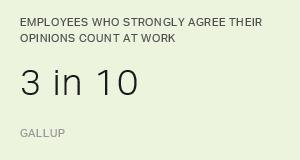Story Highlights
- Employees who feel comfortable expressing themselves are more engaged
- Internal organizational culture is built through workplace relationships
- Creating space for affirming conversations can help create a positive work culture
Why do employees sometimes remain silent when they should speak up? Do they fear consequences or repercussions? Do they feel like new ideas can't be respectfully considered without an onslaught of criticism about its inherent risks, a barrage of demands for a detailed project plan, or an insistence on immediate proof of an overinflated ROI?
Put plainly, why do we hold back our potential contributions when we know a project or process is broken or headed for disaster?
Because it's not safe to engage. The benefit of saying nothing tends to far outweigh the benefit of speaking up. Employees fear their ideas will be rejected to their detriment, or that managers will go so far as to penalize them. So, they keep their heads down and their mouths shut. I'd imagine the workers at Volkswagen who failed to speak up about fudged emissions numbers can probably relate.
Gallup's data reveal that just three in 10 U.S. workers strongly agree that at work, their opinions seem to count. However, by moving that ratio to six in 10 employees, organizations could realize a 27% reduction in turnover, a 40% reduction in safety incidents and a 12% increase in productivity.
Dr. Amy Edmondson, a professor at Harvard Business School, uses the term "psychological safety" and defines it as "a climate in which people are comfortable being (and expressing) themselves." Edmondson has confirmed that psychological safety predicts quality improvements, learning behavior and productivity. An internal study conducted by Google found that teams with high rates of psychological safety were better than other teams at implementing diverse ideas and driving high performance. They were also more likely to stay with the company.
A culture of psychological safety enables employees to be engaged. They can take risks and experiment. They can express themselves without the fear of failure or retribution. Juxtapose this type of culture with one where employees feel too intimidated to speak up or share a new idea. It's hard to imagine these employees can mentally allow themselves to be engaged at work.
Four Questions That Lead to Psychological Safety
I recently worked with a client organization that hired a new CHRO to help enact a turnaround, starting with the HR department. After a time, things still weren't getting better. The CHRO was frustrated with how long the transition was taking, yet the team still felt too much uncertainty to be fully engaged. It was clear to me that no one in the department felt safe defending or actively pursuing a new idea, an opinion or a criticism -- they were worried about their job. The environment wasn't negative; it included plenty of cordial interaction and can-do spirit in person. But it was unproductive once real work began.
I got the team together in a conference room and posed four questions to them:
- What can we count on each other for?
- What is our team's purpose?
- What is the reputation we aspire to have?
- What do we need to do differently to achieve that reputation and fulfill our purpose?
The questions are designed to create a culture of psychological safety. Please note that the order is as important as the questions themselves. The first question speaks to strengths and is fundamental for establishing individual security before diving into the broader team psychological safety challenges.
After some preparatory education and activity, I asked the first person to my right, "So, what can these people count on you for?" She thought for a minute and said, "Above all, you can always count on me to meet deadlines. I will never deliver late." The people around the table all nodded. "But doesn't everyone do that?" she asked. Then team members began sharing examples of occasions when her timeliness made the difference in their success, and she began to realize that her team truly valued and genuinely needed her contribution to their work.
I asked the next person what the team could count on him for, with the same affirmative result. Eventually, everyone heard -- out loud -- from their teammates that their specific contribution was unique, appreciated and highly valued. One by one, each member of the team expressed what they believed they contributed to the team, and each was validated and felt more secure.
It was a good start, but the team needed to dig deeper to create the kind of safety that leads to real business improvement. They needed to align with a shared purpose and identity. I pushed them to think through these elements together. Why do they come to work every day? What is the purpose of HR in that company? How do they achieve that purpose together? Then, with that purpose and process in mind, what do they aspire to be known for in the company? What is the brand they want to create?
The team members eventually came up with their "Guiding Principles." Today, they use these principles to reinforce a shared direction, approach, unity and identity, ultimately building an ever-deepening sense of safety among team members.
Some of the ways the team uses these principles are practical: They use them to filter out and prioritize staff meeting agendas, based on whether agenda topics meet the principles. The HR team uses them when they interact with business partners, setting expectations and accountability partners with its stakeholders.
Some of the uses, however, are a little more theoretical. When a team member needs to ask for help, or bring a new idea or challenge to an existing process, they can couch their request in the language the team uses to describe its collective purpose or brand. The CHRO uses the team's principles to explain behavior and coach performance. By consistently using them across the board, these shared Guiding Principles help them to talk and work together in a way that promotes individual and team psychological safety.
Six months after creating and implementing its Guiding Principles, the team took a reading of its engagement using Gallup's Q12 employee engagement survey. The team's score shot up 0.70 points on the Q12's five-point scale. For context, 0.20 is a meaningful improvement.
Building the Culture of Psychological Safety
While critical elements like organizational structure, process and system considerations can influence a company culture, the behavioral side of culture is built person by person, team by team, day by day. Team and individual safety are both essential, but individual safety must come first in the process of building psychological safety. And it must come first for any hope of improved engagement and performance.
That's what the answers to the four questions gave to the individuals on the HR team -- a safety net with which to trust and be open with each other. It allowed them to be vulnerable enough to be engaged. Exploring those four questions can do the same for any team or organization that wants to create a culture of psychological safety. Leaders and managers can use the four questions to encourage participation, ideation and honesty. Ideally, every team in an organization would work through the four questions to get to its shared value, purpose and identity. In the best case scenario, for real culture change to transpire, this has to include -- and start with -- the executive team. Leaders should answer the four questions from a team and organizational perspective. It is when leaders then share their organizational answers with the rest of the company that the expected behavior is encouraged and alignment occurs.
While culture change rarely follows a straight-and-narrow line, a single team can spark a social contagion in an organization. Managers don't have to wait. They can foster psychological safety within their workgroups immediately by posing and talking through the four questions above. They can create an environment where people are safe to engage, safe to address the elephant in the room and safe to put their whole selves into their work.
Learn more about how Gallup can help you achieve higher levels of engagement and performance by instilling a culture of psychological safety within teams:
- Inquire about our employee engagement solutions to find out more about our easy-to-use tools and resources.
- Bring our Leading High-Performance Teams course to your organization and help all managers understand how to build an engaging environment.
- Empower employees and teams to discover and develop their strengths using our CliftonStrengths assessment.


